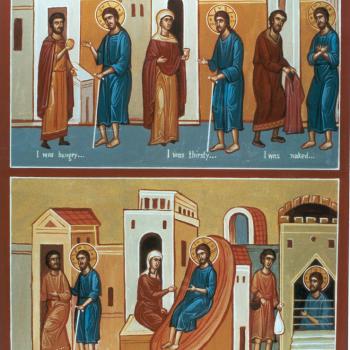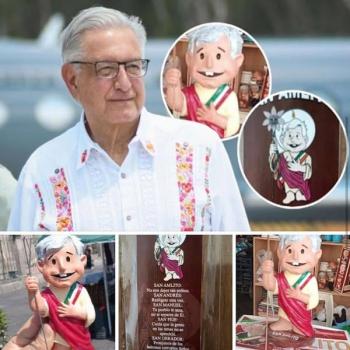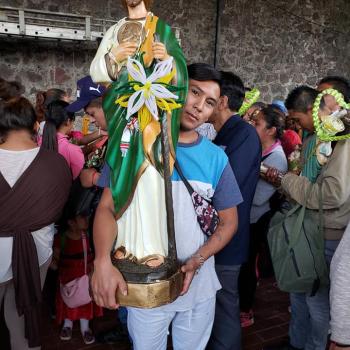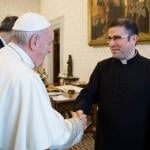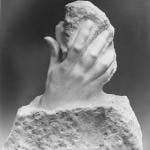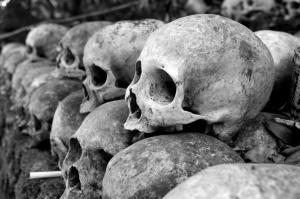
Authored by guest contributor Dr. Kate Kingsbury*
The Bamiléké of Cameroon have long believed that after the corpses of their ancestors have rotted they can be exhumed and the skulls used to communicate with the spirits of the dead, as well as their godhead, to receive spiritual guidance. Locals have named this form of ancestral worship: La Culte des Crânes, or the Skull Cult. The religious rite, which has necromancy at its fulcrum, is of ancient origin and the Bamiléké have practiced it for thousands of years. Urbanisation has impinged upon the Skull Cult as it is forbidden to move ancestral skulls, which must at all times remain in the natal village of the deceased. Nevertheless, city-dwellers who are beset by misfortune may travel to the birth places of their ancestors to honour them and perform rites to propitiate them. However, although urbanisation has adversely affected the practice, it is the Catholic Church that has most infringed upon the Skull Cult. Due to pressure from the officiants of the local Catholic Church, which has labelled the skull cult ‘barbaric’ and even ‘satanic’, the practice has faced demonisation and is thus now often conducted in secret. As I argue in this article, the Catholic Church’s vituperation of the practices is highly hypocritical, as ossuary relics also form the basis of rites at the fulcrum of their religious praxis.
Ancestor worship is widespread across Africa and comprises a key element in traditional beliefs. Amongst the Bamiléké the skull cult is a legacy that perdures from the practices of their ancestors. The latter are said to have hailed from ancient Egypt. These Egyptian ancestors preserved and mummified the bodies of the dead. But during the ninth and second half of the eleventh century a war broke out and the Bamiléké, fugitives of the conflict, fled the region eventually arriving in Cameroon. Transporting the remains of their parents, grandparents and great-grandparents in toto was impossible, nevertheless rather than leave their dearly departed behind they decided to retain only their heads in a jar and inhume the rest.
Amongst the Bamiléké ancestors have traditionally played a vital role. An ancestor is said to have meandered to the world where the dead generations who have preceded the living reside, including the Godhead known as Si who is in Bamiléké cosmogony the ultimate ancestor and originator of all life. Si is difficult to define as Si is conceived of in abstract terms but represents the energy force that impregnates all life, animating all things in the universe. Ancestors although demised retain an important place amongst the living. Upon the passing of a family member it is believed that their voyage commences with death, however this is not the grand finale, for they return, symbolically resurrected at the skull ceremony when they are exhumed from the earth.
Upon their disinterment ancestors return as active members of the family. Each skull is kept in a glass jar or box and together the dead reside in a special house called the skull hut. This is not a mausoleum but rather a dynamic space dedicated to one or more deceased family members. Although physically their skulls axiomatically evince the demise of the family member, the ancestor is said to “live” for they are given offerings of food, told about and consulted with regarding events and important family decisions. Rapports therefore are believed to be bilateral and the living nurture their relationship with the dead to receive spiritual guidance. Ancestors are said to participate with a discrete, but firm, authority in quotidian family affairs. Although their intervention may be solicited, it is also dreaded. The benevolent powers of the ancestors may provide spiritual aegis, nevertheless the wrath of an ignored or maltreated ancestor may instigate death, sickness and misfortune. Traditionally rituals were therefore followed scrupulously to avoid doh touǝ pfe, the curse of the ancestors.
Elders, despite fearing the curse of the ancestors and even referring to it to explain misfortunes have oscillated between adhering to the prescriptions of Christianity and their traditional ancestral practices. Fascinatingly, the Catholic Church has vituperated the skull cult. Whilst some Priests have attempted to establish a dialogue with elders and accommodate local practices such as the Bishop of Bafoussam, Monsignor Dieudonné Watio, who maintains that Bamileke can respect their traditions, speak to their dead, but must not consider them as mediators with God, others have vehemently denounced the skull cult. More recently Charismatic Catholic Renewal movements have labelled the Skull Cult in Cameroon as Satanic and pagan, some Priests even declaring that ancestors are the devil in disguise and affirming that only their rites of demonic deliverance can liberate those possessed. There is an outrageous irony in such denunciations.
In the religious economy of Cameroon, such statements not only smack of neocolonialism and hypocrisy but are also tainted with proselytisation propaganda. After all, the Catholic Church has long adhered to similar practices involving the bones of saints which are ritually perceived as sacred reliquaries. Indeed the process of relic acquisition is the same for both Catholics and the Skull Cult. The principle is the exhumation of the body and the recovery of the remains of the deceased. The skulls of African ancestors are preciously preserved in a special house called skull hut. The relics of the Catholic saints are caringly kept in large glass boxes called reliquaries. The glass boxes allow for the transportation of Catholic bones from one country to another, protecting them, whilst innumerable Catholic faithful visit them to imbibe the sacrality said to be imbued in these relics. Roman Catholics as well as the followers of the skull cult consider these ossuary remains as intercessors between believers and God, yet in Cameroon these practices are lambasted by the Catholic church.
Rituals also show parallels, as amongst the Bamiléké one contacts one’s ancestors to ask them to intercede with Si, God, in order to heal health ailments. Similarly, in the Catholic Church novenas to particular saints to ask them for God’s aid are advised for the resolution of diseases and sickness. St. Teresa of the infant Jesus, for example, is supplicated to cure tuberculosis. In Cameroon, Father Antoine Evouna of the Archdiocese of Yaoundé publicly testified that his broken foot was miraculously cured just by touching the reliquary of St. Teresa of the infant Jesus. Despite the Catholic Church coming head to head with Bamiléké elders as per the traditional religious practice, belief in the skull cult, although diminished, has not dwindled away entirely.
In more recent years, as a Bamiléké woman I met in Edmonton named Velila attested to me, many seek to return to such practices. ‘Although the Church is not keen on the skull cult most Cameroonians believe that as long as you are contacting your ancestors to ask for good and not to seek evil for others, you are not doing anything wrong’. Velila, although she no longer practiced ancestor worship and attended Church every Sunday, had elder relatives who still adhered to the rites. Nevertheless, it seems that although the Bamiléké seek to preserve their traditions, Catholic priests zealously denounce the idea that one can contact God through an ancestor, believing it to be pure skulduggery.
*Dr. Kate Kingsbury obtained her doctorate in anthropology at the University of Oxford, where she also did her Mphil. Dr. Kingsbury is a polyglot fluent in English, French, Spanish. She is a polymath interested in exploring the intersections between anthropology, religious studies, philosophy, sociology and critical theory. Dr. Kingsbury is Adjunct Professor at the University of Alberta, Canada. She is fascinated by religious phenomena, not only in terms of their continuity across the Holocene and into the Anthropocene but equally interested in the changes wrought to praxis and belief by humans ensuring the infinite esemplasticity that is inherent to all religions, allowing for their inception, survival, alteration, regeneration and expansion across time and space. Dr. Kingsbury is a staunch believer in equal rights and the power of education to ameliorate global disparities. She also works pro bono for a non profit organisation that aims to empower and educate girls in Uganda. Follow Dr. Kingsbury on Twitter







